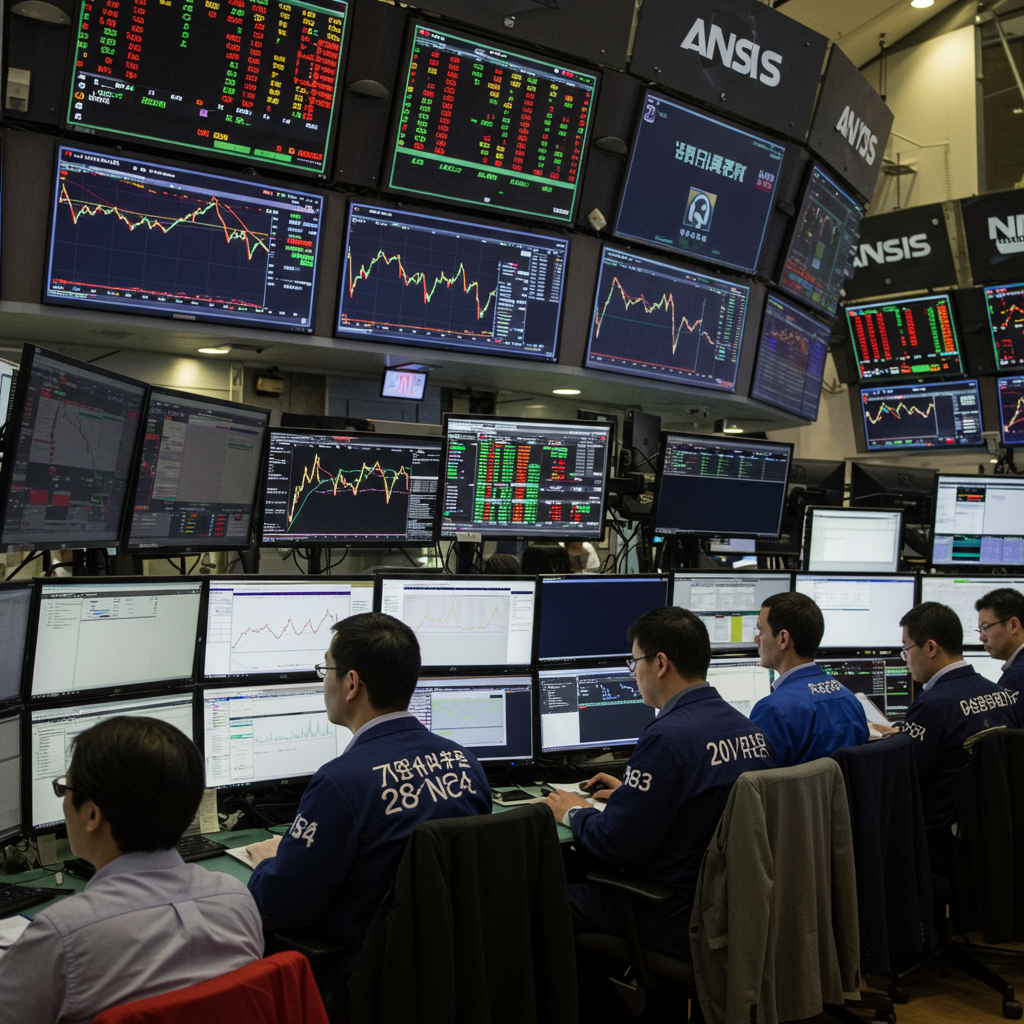Asia-Pacific markets started the week with a mixed performance this Monday. Investors actively processed a range of fresh economic data. Developments surrounding ongoing trade negotiations also influenced sentiment across the region. While some key indices posted gains, others faced headwinds.
A Mixed Start to the Week for Asia-Pacific Stocks
Monday’s trading session saw a blend of upward and downward movements across major Asia-Pacific stock markets. This divergence reflected investors’ varied reactions to recent economic releases. The day’s activity highlighted the sensitivity of regional markets to key data points and the ever-present uncertainty from global trade discussions. Major economies like China, South Korea, and Japan released figures that provided new insights into their economic health. These reports became central to market participants’ decision-making processes throughout the day.
China Data Fuels Stimulus Hopes Amid Manufacturing Slump
A significant data release impacting Monday’s trade was China’s purchasing managers’ index (PMI) for June. The official PMI reading indicated a contraction in manufacturing activity. This marked the third consecutive month of shrinking factory output. The persistent weakness in manufacturing fueled expectations among investors. Many now anticipate that Beijing may introduce further stimulus measures. These measures would aim to cushion the economy from the impact of ongoing trade disruptions. These disruptions continue between China and the United States.
Following the data, mainland China’s CSI 300 index showed resilience. It managed to add 0.37% by the end of the day, closing at 3,936.08. In contrast, Hong Kong’s Hang Seng Index faced pressure. It finished the session down by 0.87% at 24,072.28. The performance of these indices underscored the differing interpretations of the economic outlook. Hopes for stimulus supported mainland shares. Broader concerns weighed on the Hong Kong market.
Key Economic Indicators Across the Region
Beyond China, several other key economies released important data. These figures provided a more complete picture of the regional economic landscape. Investors carefully analyzed these reports for signs of strength or weakness. The data releases from South Korea and Japan were particularly closely watched.
South Korea’s Production Hits Setback
South Korea’s industrial production figures for May presented a notable concern. Data released on Monday showed that factory output declined for the second straight month. The industrial production index fell by 2.9% in May compared to April. This was a significant miss compared to economists’ expectations. A Reuters poll had forecasted a much smaller 0.1% contraction. This followed a 0.6% decline recorded in April.
On a year-on-year basis, the picture was also less encouraging. The index saw a modest increase of just 0.2% in May. This was a sharp deceleration from the 5.1% rise posted in April. It also fell short of the 2.6% increase tipped by economists. Separate data indicated that South Korea’s retail sales were flat in May. This came after a 0.9% decline in April. Despite this somewhat downbeat economic data, South Korea’s Kospi index managed to close 0.52% higher at 3,071.70. The smaller-cap Kosdaq index finished the day largely unchanged at 781.50.
Japan’s Industrial Output Disappoints Slightly
Preliminary data from Japan also showed softer industrial production than anticipated. Industrial output increased by a modest 0.5% in May from the previous month. This rise was significantly less than the 3.5% gain economists polled by Reuters had expected. Key industries did contribute positively to the gain. These included production machinery and motor vehicles. However, weakness was observed in other important sectors. These included transport equipment, chemicals, and electronic parts.
Despite the slightly disappointing production data, Japan’s markets performed strongly. The Nikkei 225 index climbed 0.84% to end the day at 40,487.39. Earlier in the session, the Nikkei had touched an over 11-month high. The broader Topix index also advanced. It gained 0.43% to close at 2,852.84. This performance suggested that positive momentum or other factors were outweighing the specific industrial output figures for Japanese investors on the day.
Performance Across Other Major Markets
Beyond the spotlight on China, South Korea, and Japan, other significant markets in the Asia-Pacific region saw varied results. Australia’s benchmark index posted a gain. The S&P/ASX 200 increased by 0.33%. It ended the day at 8,542.30. This performance reflected a generally positive mood among Australian investors.
In contrast, markets in India trended lower. The benchmark Nifty 50 lost 0.53%. The BSE Sensex also dropped by 0.54%. These declines occurred during the afternoon trading session. India’s market movement ran counter to the gains seen in Australia, Japan, and South Korea (Kospi).
Company Spotlight: IPO Excitement and EV Forecasts
Individual company news also played a role in specific market movements. Hong Kong’s tech sector showed a degree of resilience on Monday. This occurred despite the broader Hang Seng Index decline. The Hang Seng Tech Index saw a slight rise, last trading 0.12% higher. Top performers included Kingsoft Corporation, Kuaishou Technology, and Tencent Music Entertainment Group, with notable gains.
A dramatic debut occurred on the Hong Kong Exchange. Shares of Thai coconut water maker IFBH surged significantly. They rose as much as 67% shortly after trading began. The shares hit HK$46.50 after being priced at HK$27.80. The initial public offering (IPO) was massively oversubscribed. It saw strong participation from institutional investors.
Conversely, shares of Hong Kong-listed electric vehicle manufacturer Li Auto saw a sharp drop. They plunged as much as 4.34% in early trade. This followed the company’s announcement of a reduced delivery forecast for the second half of the year. Li Auto now expects to deliver around 108,000 vehicles from July to December. Its previous forecast ranged from 123,000 to 128,000 vehicles. The company attributed the change to a sales system upgrade. This upgrade was undertaken to support long-term growth.
Global Context: Following a Strong Finish on Wall Street
Monday’s mixed trade in Asia followed a strong finish for U.S. equity markets on the preceding Friday. All three key benchmarks on Wall Street rose sharply. The broad-based S&P 500 hit a new record high. It ended Friday’s session about 0.5% higher at 6,173.07. This surpassed its previous record. The Nasdaq Composite also reached an all-time high. It closed at a record after adding about 0.5%. The Dow Jones Industrial Average rose by nearly 1%.
These three benchmarks have shown a sharp recovery. This rally began from lows seen in April. Those lows coincided with the height of trade policy tensions. The positive momentum from the U.S. session provided some support to Asian markets at the open. However, the ongoing volatility related to global trade negotiations remains a significant factor. It can quickly sway market sentiment. It continues to pose an ongoing threat to the strength and sustainability of the recent equity rally.
Expert Analysis: Why Data and Trade Remain Key Drivers
The market’s reaction on Monday underscores the critical influence of economic data and trade dynamics in Asia-Pacific. Specific indicators like China’s PMI are vital pulse checks on the region’s manufacturing powerhouse. A third consecutive contraction signals underlying challenges, likely linked to global demand and trade frictions. This puts pressure on policymakers to act. Hopes for stimulus often counter negative data prints. However, relying on stimulus can also signal a lack of organic economic strength.
Similarly, industrial output figures from Japan and South Korea provide real-time insights. They show the health of major export-oriented economies. Missing economists’ forecasts, even slightly, can temper optimism. It suggests external demand might not be as robust as hoped. This directly impacts corporate earnings and investor confidence. Meanwhile, the unpredictable nature of trade negotiations adds a layer of complexity. Tariffs, export restrictions, and political rhetoric can shift market sentiment rapidly. This creates volatility that investors must constantly navigate. For businesses, this uncertainty makes planning difficult. For markets, it translates into hesitant trading patterns and potential sharp swings.
Outlook: Navigating Uncertainty in Asia-Pacific Markets
Looking ahead, market participants in the Asia-Pacific region will remain focused on these key themes. Future economic data releases, particularly from China, will be crucial. They will confirm whether recent weakness persists or if stimulus efforts gain traction. The pace and effectiveness of any potential stimulus measures will be closely watched. Investors will also monitor further data points from South Korea and Japan. These will provide updates on their manufacturing and export sectors.
The trajectory of trade negotiations, especially between the U.S. and China, will continue to be a major source of uncertainty. Any new developments, positive or negative, could trigger significant market reactions. Geopolitical factors and central bank policies in the U.S. and Europe also play a role. They influence global demand and capital flows. Navigating this environment requires staying informed about both regional specifics and the broader global economic context. Investors should prepare for continued volatility as these forces interact.
Frequently Asked Questions
Why did China’s manufacturing data significantly impact Asia-Pacific markets this Monday?
China’s manufacturing PMI is a key indicator of its economic health, particularly its vast industrial sector. The report showing a third consecutive month of contraction in June raised concerns about the pace of growth. It suggested external demand or domestic factors were slowing down production. This weakness fueled speculation that the Chinese government might implement further economic stimulus measures, which can positively impact markets by boosting liquidity and supporting businesses. The mixed reaction in Chinese shares (CSI 300 up, Hang Seng down) reflected this interplay between economic worry and stimulus hopes.
Which major Asia-Pacific stock indices recorded gains during the mixed trading session on Monday?
Despite the overall mixed picture, several key stock indices in the Asia-Pacific region closed higher on Monday. These included mainland China’s CSI 300 index, which rose 0.37%. In Japan, the Nikkei 225 climbed 0.84%, hitting an 11-month high, and the broader Topix index advanced 0.43%. South Korea’s Kospi index also gained 0.52%. Australia’s S&P/ASX 200 increased by 0.33%. This contrasts with declines seen in Hong Kong’s Hang Seng Index and India’s Nifty 50 and Sensex.
How do economic data releases like industrial output figures influence investor decisions in Asia-Pacific markets?
Economic data releases like industrial production figures are vital for investors as they provide concrete evidence of economic activity. Industrial output reflects the health of the manufacturing sector, a major driver in many Asian economies. A strong report suggests robust economic growth and potentially higher corporate profits. A weak report, especially if it misses expectations, signals potential slowdowns, reduced demand, and risks to company earnings. Investors use this information to adjust their expectations for economic growth, inflation, and central bank policies, which in turn influences their investment decisions and asset allocations across markets.
Conclusion
Monday’s trading in Asia-Pacific was a complex picture, reflecting the tug-of-war between varying economic signals and ongoing trade uncertainties. While key data points from China, South Korea, and Japan presented a somewhat cautious outlook, hopes for policy intervention and positive momentum from the previous U.S. session provided pockets of strength. As the week unfolds, market focus will likely remain on incoming economic data and any developments in global trade relations, factors that will continue to shape the trajectory of regional indices and investor sentiment.




